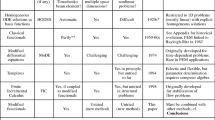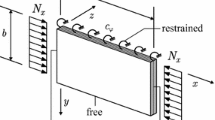Abstract
Whenever a critical point in a non-linear finite element analysis is reached, an implicit Newton procedure is prevented from proceeding until the stiffness matrix is stabilized. Most stabilization procedures result in a damped Newton scheme. This can cause a reduced convergence rate. Based on documented stabilization strategies, an iterative procedure to reduce negative impact on the convergence rate resulting from the damping is to be proposed here. This will be done by a corrector iteration carried out between two successive equilibrium iterative steps. The equilibrium iteration is a Newton–Raphson scheme. Since the stiffness matrix has already been factorized within the preceding standard equilibrium iterative step, the stiffness matrix will be held constant during the corrector iteration, which in turn allows for a computational efficient treatment of the additional iterations. The proposed procedure has been strongly driven by Wright and Gaylord’s (ASCE J. Struct. Div., 94, 1143–1163, 1968) investigation.
Similar content being viewed by others
References
Allgower EL, Geoar K (1970) Numerical continuation methods. Springer, Heidelberg, p 388
Bathe K-J (1990) Finite-elemente-methoden. Springer, Heidelberg, p 820
Belytschko T, Liu WK, Moran B (2004) Nonlinear finite elements for continua and structures. Wiley, Chichester, p. 650
Crisfield MA (1981) A fast incremental/iterative solution procedure that handles snap-through. Comput Struct 13: 55–62
Felippa CA (1987) Penalty spring stabilization of singular Jacobians. Trans ASME 54: 728–729
Felippa CA (1987) Transversing critical points with penalty springs. In: Pande GN, Middleton J (eds) Proc. Int. Conf. Num. Meth. Engng.: Theory and Applications, NUMETA 87, vol 2: Transient/dynamic analysis and constitutive laws for engineering materials, Swansea, 6–10 July, 1987. Martinus Nijhoff, The Hague C2/1–8
Kröplin B-H, Dinkler D (1982) Eine Methode zur direkten Berechnung von Gleichgewichtslagen im Nachbeulbereich. Ing Arch 51: 415–420
Kröplin B-H, Dinkler D (1982) A creep type strategy used for tracing the load path in elastoplastic post buckling analysis. Comput Methods Appl Mech Eng 32: 365–376
Kröplin B-H, Dinkler D (1985) Quasi viscous analysis and arc-length-method. In: Middleton P (ed) NUMETA 85 Numerical methods in engineering: theory and applications, vol 2. AA Balkema, Rotterdam, pp 743–747
Lee SL, Manuel FS, Rossow EC (1968) Large deflections and stability of elastic frames. ASCE J Eng Mech Div 94: 521–547
Ma C, Besdo D (1989) Erweiterung eines Iterationsverfahrens zur Lösung stark nichtlinearer Steifigkeitsgleichungen. ZAMM 69: 214–216
Müller M (2005) Procedure for the implicit post buckling analysis with finite elements by stabilizing the global stiffness matrix. PAMM 5: 435–436
Müller M (2006) Passing of instability points by applying a stabilized Newton–Raphson scheme to a finite element formulation. Comput Mech 40: 683–705
Müller M (2008) Postbuckling analysis by applying a completely spring-stabilized extended system. Submitted to Comput Struct
Oliver J, Onate E (1984) A total lagrangian formulation for the geometrically nonlinear analysis of structures using finite elements. Part I: Two-dimensional problems: Shell and plate structures. Int J Num Meth Eng 20: 2253–2281
Oliver J, Onate E (1986) A total lagrangian formulation for the geometrically nonlinear analysis of structures using finite elements. Part II: arches, frames and axisymmetric shells. Int J Num Meth Eng 23: 253–274
Ortega JM, Rheinboldt WC (2000) Iterative solution of nonlinear equations in several variables. SIAM Society for Industrial and Applied Mathematics, Philadelphia, p 572
Press WH, Teukolsky SA, Vetterling WT, Flannery BP (2003) Numerical recipes in Fortran 77, vol 1. Cambridge Press, Cambridge, p 933
Ramm E (1976) Geometrisch nichtlineare Elastostatik und Finite Elemente. Bericht Nr 76-2, Inst. f. Baustatik Universität Stuttgart, p 175
Riks E (1972) The application of Newton’s method to the problem of elastic stability. J Appl Mech 39: 1060–1066
Sabir AB, Lock AC (1973) The application of finite elements to the large deflection geometrically non-linear behaviour of cylindrical shells. In: Brebbia T(eds) Variational methods in engineering, vol 7.. Southampton University Press, Southampton, pp 66–75
Schweizerhof KH (1989) Quasi-Newton Verfahren und Kurvenverfolgungsalgorithmen für die Lösung nichtlinearer Gleichungssysteme in der Strukturmechanik. Schriftenreihe des Institutes für Baustatik Heft 9, University of Karlsruhe, p 162
Seydel R (1988) From equilibrium to chaos—practical bifurcation and stability analysis. Elsevier, New York, p 367
Sharifi P, Popov EP (1971) Nonlinear buckling analysis of sandwich arches. ASCE J Eng Mech Div 97: 1397–1411
Wagner W, Wriggers P (1988) A simple method for the calculation of postcritical branches. Eng Comput 5: 103–109
Wagner W (1991) Zur Behandlung von Stabilitätsproblemen der Elastostatik mit der Methode der Finiten Elemente. Forschungs- und Seminarberichte aus dem Bereich der Mechanik der Universität Hannover, Bericht-Nr. F91/1, p 200
Wood RD, Zienkiewicz OC (1977) Geometrically nonlinear finite element analysis of beams, frames, arches and axisymmetric shells. Comput Struct 7: 725–735
Wriggers P, Wagner W, Miehe C (1988) A quadratically convergent procedure for the calculation of stability points in finite element analysis. Comput Methods Appl Mech Eng 70: 329–347
Wriggers P, Simo JC (1990) A general procedure for the direct computation of turning and bifurcation points. Int J Num Methods Eng 30: 155–176
Wriggers P (2001) Nichtlineare finite-element-methoden. Springer, Berlin, p 495
Wright EW, Gaylord EH (1968) Analysis of unbraced multistory steel rigid frames. ASCE J Struct Div 94: 1143–1163
Zienkiewicz OC, Taylor RL (1991) The finite element method, vol. 2, solid and fluid mechanics dynamics and non-linearity. McGraw-Hill, London, p 807
Author information
Authors and Affiliations
Corresponding author
Rights and permissions
About this article
Cite this article
Müller, M. Postbuckling analysis stabilized by penalty springs and intermediate corrections. Comput Mech 42, 631–654 (2008). https://doi.org/10.1007/s00466-008-0264-4
Received:
Accepted:
Published:
Issue Date:
DOI: https://doi.org/10.1007/s00466-008-0264-4




